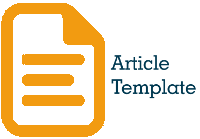FINGER GESTURE RECOGNITION TO CONTROL VOLUME ON COMPUTER USING OPENCV AND MEDIAPIPE LIBRARY
DOI:
https://doi.org/10.35457/antivirus.v16i2.2508Keywords:
Mediapipe, Gesture Recognition, Finger Landmark, volume control, machine learningAbstract
Gesture recognition is a part of artificial intelligence in the field of computer vision. With gesture recognition, the computer is able to understand the movements captured on the camera/webcam. The benefits of gesture recognition are many, one of which is what researchers are doing regarding hand-tracking gesture recognition of the human right-hand finger to adjust the volume control on a computer or laptop. Based on this background, this research is intended to apply machine learning developed from the OpenCV and MediaPipe libraries to carry out the process of training and testing finger gestures as gestures to control one of the functions in Windows, one of which is volume control. This process uses the OpenCV Library and MediaPipe because they are capable of multiprocessing with real-time data, so the gesture identification process is faster and more accurate. When the camera/webcam captures the frame of the movement of the human's right-hand finger gesture, an augmentation process is carried out and the provision of keypoint localization landmarks is carried out for each knuckle. In this study, only the fingertip landmarks and index finger landmarks were recognized. Machine learning will perform calculations from the distance between the tip of the thumb and the tip of the forefinger which is used to determine changes in the volume of the sound. From the test results of nine trials with different finger poses, 88.89% was obtained. One of the test results failed to read finger movement gestures, due to the landmark position of the tip of the index finger which was closed with the other fingers.
Downloads
References
M. E. A. Rivan and A. Setiawan, "Pengenalan Gestur Angka Pada Tangan Menggunakan Arsitektur AlexNet Dan LeNet Pada Metode Convolutional Neural Network," Jurnal Sistem Komputer, vol. 11, pp. 19-28, 2022.
H. Yunita and E. Setyanti, "Hand Gesture Recognition Sebagai Pengganti Mouse Komputer Menggunakan Kamera," Jurnal ELTIKOM, vol. 3, pp. 64-76, 2019.
T. C. A.-S. Zulkhaidi, E. Maria, and Yulianto, "Pengenalan Pola Bentuk Wajah dengan OpenCV," Jurnal Rekayasa Teknologi Informasi (JURTI), vol. 3, pp. 181-185, 2019.
P. Priyonggo, A. Kusumah, A. Khumaidi, M. B. Rahmat, and J. Endrasmono, "Sistem Tracking Posisi Kamera Menggunakan Pengolahan Citra Untuk Pemusatan Posisi Pengambilan Video di Automation Academy," Jurnal Teknik Elektro dan Komputer TRIAC, vol. 9, 2022.
T. C. A.-S. Zulkhaidi, E. Maria, and Yulianto3, "Pengenalan Pola Bentuk Wajah dengan OpenCV," JURTI (Jurnal Rekayasa Teknologi Informasi), vol. 3, 2019.
F. Damatraseta, R. Novariany, and M. A. Ridhani, "Real-time BISINDO Hand Gesture Detection and Recognition With Deep Learning CNN," Jurnal Informatikan Kesatuan (JIKES), vol. 1, 2021.
F. Zhang et al., "MediaPipe Hands: On-Device Real-Time Hand Tracking," ArXiv, vol. abs/2006.10214, 2020.
M. R. Azharfianto, N. C. Basjaruddin, and E. Rakhman, "Pengenalan Gestur Tangan Berbasis Augmented Reality dan Metode Logika Fuzzy Untuk Mengendalikan Kendaraan," Industrial Research Workshop and National Seminar, vol. 9, 2018.
I. G. P. S. Wijaya, A. A. Firdaus, A. P. J. Dwitama, and Mustiari, "Pengenalan Ekspresi Wajah Menggunakan DCT dan LDFA Untuk Aplikasi Pemutar Musik (Moodsic)," Jurnal Teknologi Informasi dan Ilmu Komputer (JTIIK), vol. 5, pp. 559-565, 2018.
H. M. Putri, F. Fadlisyah, and W. Fuadi, "Pendeteksian Bahasa Isyarat Indonesia Secara Real-Time Menggunakan Long Short-Term Memory (LSTM)," Jurnal Teknologi Terapan and Sains 4.0, vol. 3, no. 1, pp. 13-25, 2022.
A. Halder and A. Tayade, "Real-time Vernacular Sign Language Recognition using MediaPipe and Machine Learning," International Journal of Research Publication and Reviews (IJRPR), vol. 2, no. 5, pp. 9-17, 2021.
Sugiono, Penelitian kuantitatif, kualitatif dan R&D. Bandung: Alfabeta, 2014.
Downloads
Published
Issue
Section
License
Authors who publish with this journal agree to the following terms:
- Copyright on any article is retained by the author(s).
- Author grant the journal, right of first publication with the work simultaneously licensed under a Creative Commons Attribution License that allows others to share the work with an acknowledgement of the work’s authorship and initial publication in this journal.
- Authors are able to enter into separate, additional contractual arrangements for the non-exclusive distribution of the journal’s published version of the work (e.g., post it to an institutional repository or publish it in a book), with an acknowledgement of its initial publication in this journal.
- Authors are permitted and encouraged to post their work online (e.g., in institutional repositories or on their website) prior to and during the submission process, as it can lead to productive exchanges, as well as earlier and greater citation of published work.
- The article and any associated published material is distributed under the Creative Commons Attribution-ShareAlike 4.0 International License











